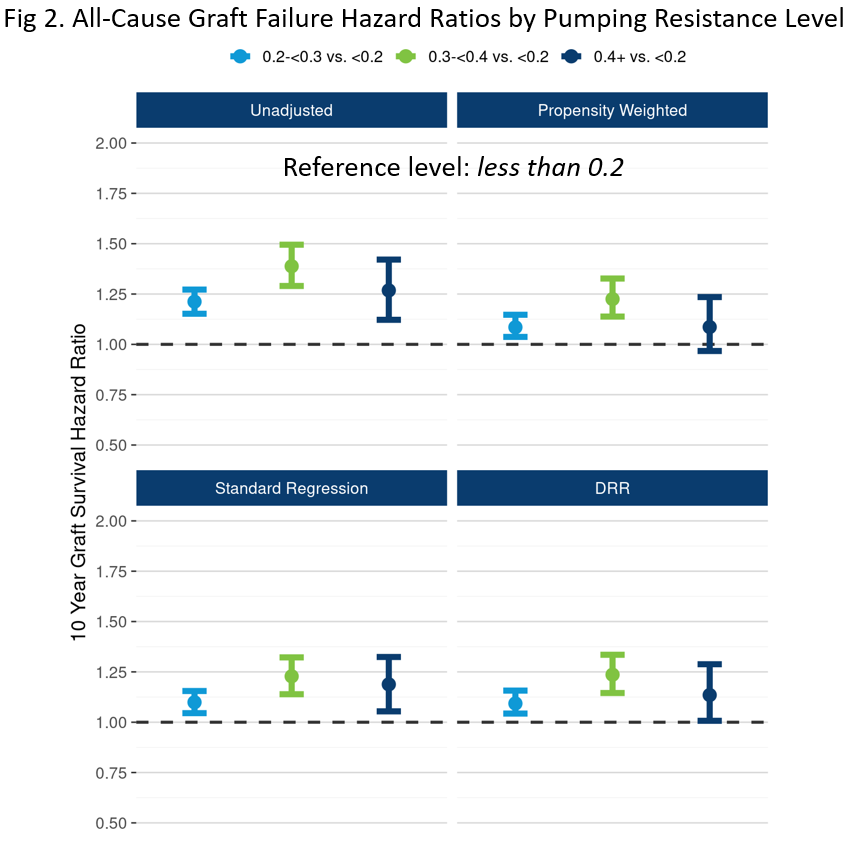Resistance Isn’t Futile: The Independent Effect of Pumping Resistance on Long-Term Kidney Graft Survival
1United Network for Organ Sharing, Richmond, VA, 2Virginia Commonwealth University Health, Richmond, VA
Meeting: 2022 American Transplant Congress
Abstract number: 394
Keywords: Graft acceptance, Kidney transplantation, Outcome, Pulsatile preservation
Topic: Clinical Science » Kidney » 32 - Kidney Deceased Donor Selection
Session Information
Session Name: Kidney Deceased Donor Selection II
Session Type: Rapid Fire Oral Abstract
Date: Tuesday, June 7, 2022
Session Time: 3:30pm-5:00pm
 Presentation Time: 4:00pm-4:10pm
Presentation Time: 4:00pm-4:10pm
Location: Hynes Ballroom C
*Purpose: Kidneys are pumped for therapeutic (to mitigate deleterious effects of ischemia), practical (to facilitate transplant scheduling), and prognostic (to assess organ quality) purposes. Yet the association between pumping’s primary prognostic measure – renal resistance (RR) – and graft survival is not well characterized. To aid transplant decision-making, the “BARETO” (Biopsy, Anatomy, and Resistance Effects on Transplant Outcomes) study aims to quantify relationships between these prognostic measures and outcomes to improve kidney offer decision-making.
*Methods: A cohort of 16,484 solitary deceased donor kidney transplants from 2008-2012 with non-missing RR as reported to the OPTN registry was used for unadjusted (Kaplan-Meier; single-variable Cox) and adjusted all-cause graft survival analysis out to 10 years. Causal inference with RR as the exposure variable was performed 3 ways using Cox regression: propensity-weighted, multivariable regression, and doubly robust regression (DRR) to adjust for 10 donor and recipient confounders including donor KDPI and recipient EPTS.
*Results: 1/3 of kidneys were pumped. Most (90%) RR values ranged between 0.1 and 0.4 mmHg/mL/min. Survival analysis revealed an unequivocally significant (p<0.0001) association between RR and all-cause graft survival probability (Fig 1). RR was highly correlated with KDPI and donor sex. The graft failure hazard ratio for RR 0.3-0.4 vs. <0.2 (HR 1.39, 95% CI: 1.28, 1.50) was only partially attenuated after DRR risk-adjustment (HR 1.24, 95% CI: 1.14, 1.34) (Fig 2). Results suggest graft failure risk does not continue to rise for RR values above 0.3-0.4, although selection bias may influence the results.
*Conclusions: After rigorous statistical adjustment, RR was found to be independently associated with graft survival. However, the detrimental effect of higher RR appears to plateau, calling into question the use of arbitrary thresholds such as 0.4 for declining a kidney. Incorporating RR as a component of multifactorial prediction models (e.g., KDRI) has the potential to improve organ offer decision-making by tempering the impact of prognostic measures on the kidney discard rate.
To cite this abstract in AMA style:
Stewart D, Foutz J, Kamal L, Gupta G. Resistance Isn’t Futile: The Independent Effect of Pumping Resistance on Long-Term Kidney Graft Survival [abstract]. Am J Transplant. 2022; 22 (suppl 3). https://atcmeetingabstracts.com/abstract/resistance-isnt-futile-the-independent-effect-of-pumping-resistance-on-long-term-kidney-graft-survival/. Accessed November 16, 2025.« Back to 2022 American Transplant Congress


